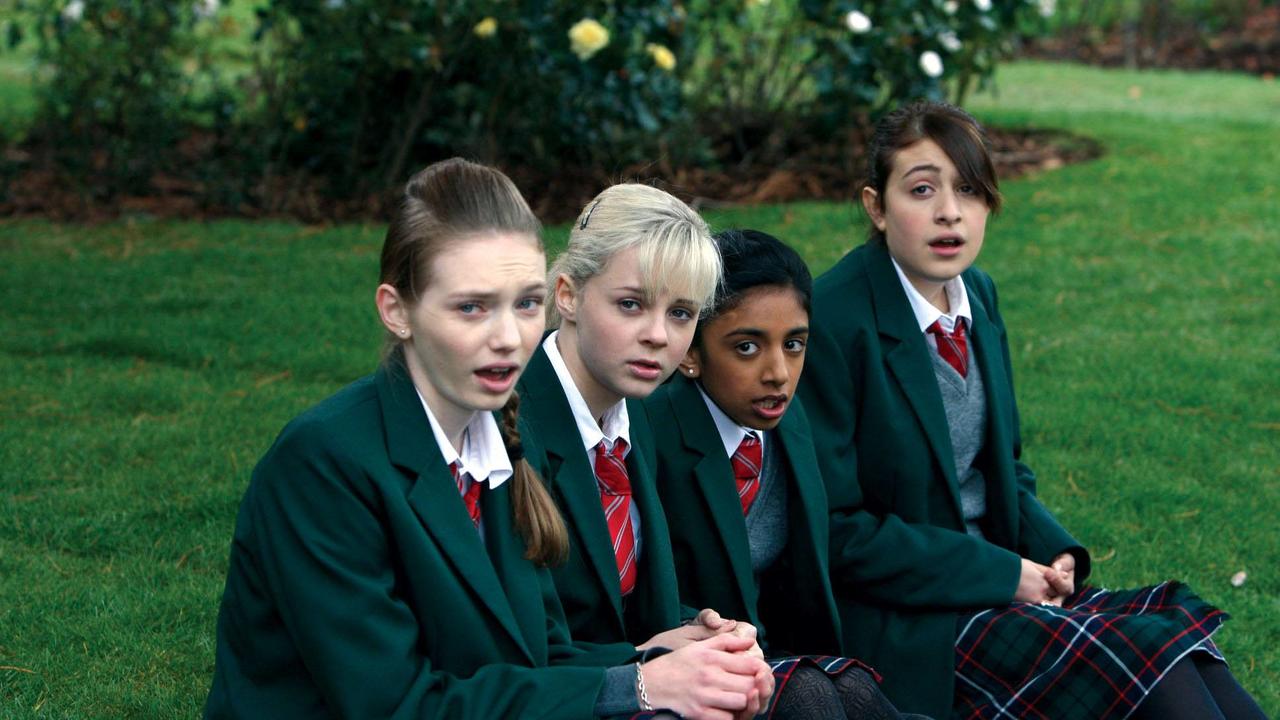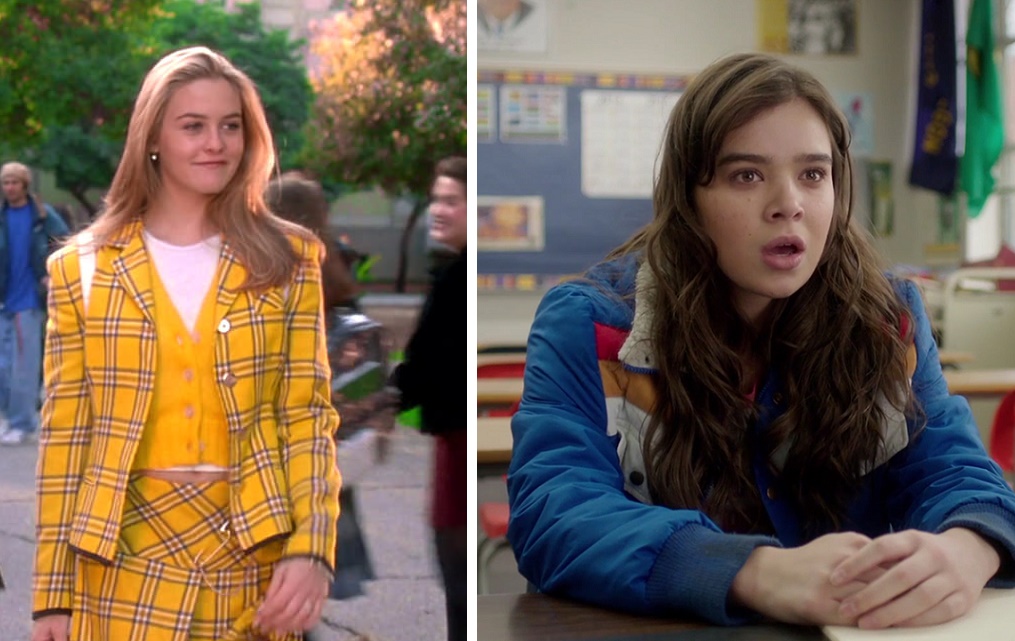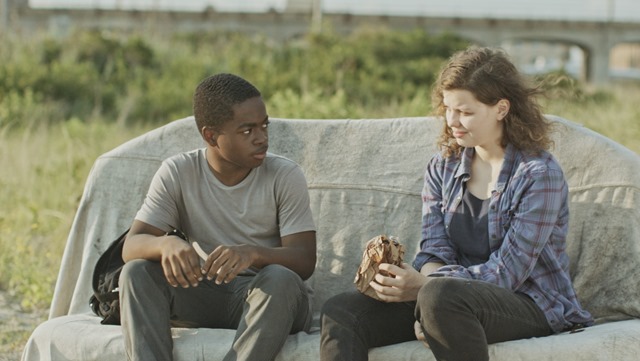This guest post written by Deborah Krieger appears as part of our theme week on Women Directors.
After chronicling the clashes among family, football, and adolescence in Bend it Like Beckham (2002), Gurinder Chadha delves into similar territory with the ebullient coming-of-age tale Angus, Thongs and Perfect Snogging (2008). An adaptation of the 1999 novel Angus, Thongs and Full-Frontal Snogging by the late Louise Rennison, the film tells the story of Georgia Nicolson (Georgia Groome), a teenager growing up in Eastbourne, England, whose entry into the world of romancing boys is as fraught and funny as you might expect.
Georgia falls quickly for the “sex-god” Robbie (Aaron Taylor-Johnson), a new boy in town, and spends the course of the film trying to win him over. In the film’s opening scene, Georgia’s friend Jas (Eleanor Tomlinson) tells her regretfully, “Boys don’t like girls for funniness.” Taking this questionable advice to heart, Georgia attempts to make Robbie fall for her by hiding her own dramatic attitude and hapless sense of humor that separate her from the other girls in town. By the end, of course, she learns the all-too-important lesson that you don’t need supermodel looks to get a boyfriend, and that your significant other should like you for yourself and not who you pretend to be.
Angus, Thongs and Perfect Snogging has a quite a bit in common with other movies and books in the “teen romantic comedy” genre. It is undoubtedly formulaic, and contains the expected happy ending and all-important positive message of self-confidence. Yet Georgia herself, and her attitude towards life, are what make the book and the film memorable, as Georgia is vividly crafted, full of recognizable flaws. She consistently makes the worst, most embarrassing social errors in nearly any given situation, including being caught spying on Robbie by him and his girlfriend; accidentally exposing her “knickers” to a crowd of partygoers (including Robbie) while fighting off another boy’s advances; or telling said boy that she’s a lesbian in order to avoid having to date him. For Georgia, her parents’ refusal to rent out a club for her fifteenth birthday constitutes the cruelest mistreatment, and she rather callously views her father’s job transfer to New Zealand as little more than an opportunity for her to have only one parent to supervise her misbehavior. (Of course, by the end of the film she realizes that she misses her dad and would rather have her family together.)
Angus, Thongs and Perfect Snogging is of opposing minds when it comes to showing how teens deal with their developing sexuality. On the one hand, many such encounters in the film are refreshingly realistic, for the most part eschewing picture-perfect kisses and idealized romantic encounters for true-to-life depictions of what being a teenager is actually like: full of awkwardness, weird mishaps, and lots of saliva. Seemingly over the course of minutes, teenage boys go from disgusting, unsanitary mysteries to objects of fledgling desire — from mere concept to attainable goal. In an early scene, Georgia’s friend Rosie (Georgia Henshaw) instructs their group of friends to sit on their hands to numb them, then to touch their chests over their clothes to simulate getting “felt up” by a boy.
On the other hand, the girls also treat sexuality in a rather cynical way: as a competition to be won, a skill to be taught and learned, and a game to be quantified and scored. Early in the film, Georgia and Jas introduce their “snogging scale,” or ten escalating forms of romantic and sexual kissing, with hand-holding while kissing at number one and “the full monty” at number ten. This scale is referenced consistently in conversations between Georgia and Jas, with them discussing their sexual experiences in terms of what number they earn on the scale. While preparing to make Robbie hers, Georgia visits the home of local boy named Peter Dyer (Liam Hess) to learn how to kiss. Peter is a local “ladies’ man” who apparently teaches snogging to all the local girls, and goes about his work with all the seriousness of a businessman. He sets a thirty-minute timer at the beginning of his lesson with Georgia, delivers questionably-sage advice, and insists that she be honest about her previous experience so that he can “evaluate” her accurately, prompting her to admit her only experience is with “the back of [her] hand.” Where other teen romances might feature the protagonist fantasizing about sharing her first-ever kiss with her crush, in the world of Angus, Thongs and Perfect Snogging kissing — and what comes after — is treated in a much more transactional (and perhaps more practical) way.
Another central aspect of the film’s narrative is the looming presence of beauty standards to which Georgia and her friends feel they must adhere if they have any hope of getting a boyfriend. After realizing that even to her own friends, her large nose diminishes her attractiveness, Georgia continually tries to change her looks in order to make herself more appealing to boys. While in pursuit of the kind of supermodel beauty that will undoubtedly make Robbie hers, Georgia also manages to lose some of her hair by trying to bleach it, accidentally shaves off one of her eyebrows, gives herself the appearance of having pink eye by putting Vaseline on her eyelashes, and turns her legs bright orange with self-tanner, which Robbie notices while the pair are swimming in a public pool. Yet despite Georgia’s perception of herself as unattractive and in need of beautifying, the film’s plot actually belies her claims, revealing her to be rather unreliable as a narrator. In addition to Robbie, whom Georgia wins over by the end of the film, naturally, she has to contend with two other boys who want to date her: the aforementioned Peter Dyer, he of the copious saliva, and Dave the Laugh, a boy she goes out with only to make Robbie jealous. Additionally, both Robbie and Georgia’s father comment disparagingly on her desire to keep changing herself, and that she is fine the way she is. Therefore, despite the early assertion in Angus, Thongs and Perfect Snogging that boys don’t like funny girls, or weird girls, or girls who don’t have the CoverGirl look, Georgia’s own travails prove otherwise, and demonstrate that she really didn’t need to change much about herself at all to get the boy she wants.
However, the film falls into some unfortunate classic teen romance narrative traps as it tries to demonstrate Georgia’s own uniqueness and establish her as the ideal girl for Robbie. Right off the bat, the film immediately draws a contrast between the inexperienced Georgia and “Slaggy Lindsay,” Robbie’s girlfriend at the beginning of the movie, and thus Georgia’s rival. (“Slaggy” basically means “slutty,” for those not of us speaking the Queen’s English.) Lindsay (Kimberley Nixon) is immediately presented as the enemy even before Robbie is in the picture, and the narrative continually backs up this assertion. Lindsay is the conventionally attractive girl who stuffs her bra and wears a thong (the horror!), while Georgia doesn’t commit those apparently unforgivable acts. Lindsay’s behavior towards Georgia over the course of the movie is presented as needlessly petty and at times cruel, even though Georgia is, admittedly, aiming for her boyfriend. Despite the fact that boyfriends can’t be stolen, it’s still a pretty selfish move on Georgia’s part, and one that manages to avoid diegetic condemnation even as many of Georgia’s sneaky and dishonest maneuvers are properly called out.
While not as prominent in the movie as in the original book, Angus, Thongs and Perfect Snogging also keenly traces the way that girls’ friendships change during adolescence when the specter of boys — and maturity — comes into the picture. Georgia’s “ace gang” of Georgia, Jas, Rosie, and Ellen (Manjeeven Grewal) are presented as the thickest of thieves, ready to go “boy-stalking” together, take beauty quizzes, and encourage one another’s romantic adventures. Yet the very first scene actually undermines the unity of the so-called “ace gang,” demonstrating the kind of social pressures that adolescent girls must contend with, and conquer, in order to maintain their friendships. The film opens with Georgia arriving at a Halloween party dressed as a stuffed cocktail olive, making more of a statement than she’d like in a room full of sexy angels, devils, and cowgirls. We then learn that the rest of the “ace gang” was supposed to go in matching costumes, yet the other three girls have decided to join their peers in wearing sexualized and attractive costumes without telling Georgia. It is both an establishing character moment for Georgia, an olive in a room of nymphets, as well as a recognizable betrayal of friendship on the part of her friends.
The greatest such rift in the film, though, comes from Jas, Georgia’s conventionally pretty “best mate,” who manages to snag Robbie’s brother Tom (Sean Bourke) early on in the film with little effort. She subsequently spends much of the film disappointing Georgia and frustrating her attempts to date Robbie, culminating in a recognizable yet tragic falling-out that lasts until the end of the movie. Jas correctly points out Georgia’s “scheming and pretending” as a cause of why Robbie won’t date her, while Georgia argues (also with some legitimacy) that Jas has been a rather poor friend when it comes to keeping her secrets. Georgia also manages to dig the hole between her and Jas deeper when she criticizes what she views as Tom’s lack of ambition, as Robbie wants to be a rockstar. Jas delivers the classic fatal blow to a teenage friendship when she announces that she will be attending Lindsay’s party instead of Georgia’s, because of course they are on the same day.
Of course, the party at the end — the club party Georgia so wanted at the beginning of the film — allows everything to be solved. Jas and Georgia reconcile (as Jas secretly helped Georgia’s mother plan the whole thing, conveniently fixing their friendship), Robbie and his band headline the party set, Robbie very publicly rejects Lindsay in front of seemingly everyone in town and declares his feelings for Georgia unequivocally, and her father doesn’t end up having to move to New Zealand. Indeed, the ending of Angus, Thongs and Perfect Snogging is the least realistic aspect of the movie — nothing in the real world resolves itself quite so easily and painlessly. Perhaps outright condemning (or at least questioning) Georgia’s perpetuation of the Taylor Swift-esque “she wears short skirts / I wear tee shirts” dynamic with Lindsay might have taken the film all the way from cliché to truly lifelike. Still, though, it’s hard not to be pleased for Georgia and her happy ending, if only because there is so much in her (mis)adventures that are very recognizable and true.
Deborah Krieger is a senior at Swarthmore College, studying art history, film and media studies, and German. She has written for Hyperallergic, Hooligan Magazine, the Northwestern Art Review, The Stake, and Title Magazine. She also runs her own art blog, I On the Arts, and curates her life in pictures @Debonthearts on Twitter and Instagram.


















